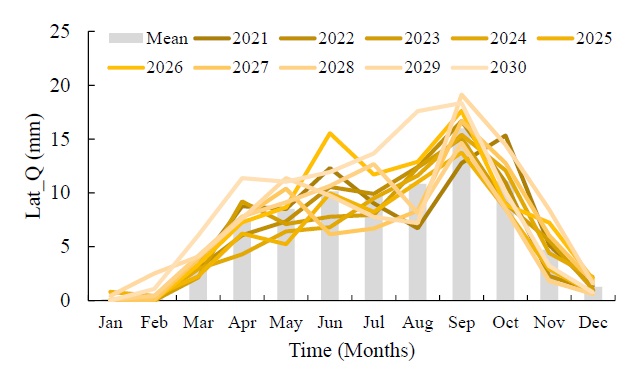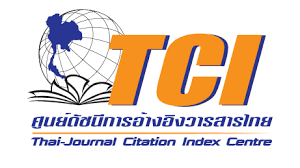Assessing the Impact of Groundwater Variability on Dam Safety Based on Flood Situation and Climate Change Scenarios Using Hydrological Model
doi: 10.14456/mijet.2024.9
Keywords:
dam safety, groundwater, runoff, SWAT, Lam Khan Chu DamAbstract
Monitoring dam behavior during severe storms is a crucial step in assessing dam safety. Utilizing hydrological models is considered an effective approach to studying dam safety by analyzing the relationship among hydrological parameters. The objective of this study is to simulate groundwater conditions associated with runoff into the Lam Khan Chu Reservoir in the northeastern region of Thailand. This is achieved by applying the SWAT hydrologic model to simulate daily runoff conditions from 2018 - 2020 and extending the analysis to the future period from 2021 - 2030 using data from the HadGEM2-AO model in RCP4.5 and RCP8.5 scenarios. The aim is to develop criteria for checking dam safety and predicting the impact of future groundwater changes. The results indicated that the SWAT model exhibited good performance in runoff calculation accuracy, as indicated by R2, NS, and PBIAS statistical indices. Additionally, the relationship between groundwater level from the SWAT-Check model and those obtained from observation wells was noteworthy. Simulating future dam safety conditions for both RCP4.5 and RCP8.5 forecasts over five years revealed that surveillance measures are necessary for Lam Khan Chu Dam during the rainy season (August - October). This is due to the groundwater showing a trend above normal in the forecasted cases for the specified period. The research methods and findings are anticipated to serve as crucial guidelines for officials overseeing dam safety. These guidelines can be applied to plan preparedness measures, facilitating the timely monitoring and resolution of situations. This applies even to dams or reservoirs lacking a Dam instrument installation.
References
K. Yoshida, S. Mallika, S. Supranee, S. Desell, and J. Janjirauttikul, “Weather-induced economic damage to upland crops and the impact on farmer household income in Northeast Thailand,” Paddy and Water Environment, vol. 17, pp. 341-349, 2019.
N. Chutiman, M. Chiangpradit, B. Kong-ied, P. Busababodhin, C. Chaiyasaen and P. Guayjarernpanishk, “Daily maximum rainfall forecast affected by tropical cyclones using grey theory,” Civil Engineering Journal, vol. 8, no. 8, pp. 1565-1573, 2022.
A. Busaman, S. Chuai-Aree, S. Musikasuwan, and R. McNeil, “Flood-Modeling and Risk Map Simulation for Mae Suai Dam-Break, Northern Thailand,” Pertanika Journal of Science & Technology, vol. 29, no. 1, 2021.
P. Sanzana, J. Gironás, I. Braud, J. F. Muñoz, S. Vicuña, S. Reyes‐Paecke, F. de la Barrera, F. Branger, F. Rodríguez, X. Vargas and N. Hitschfeld, “Impact of urban growth and high residential irrigation on streamflow and groundwater levels in a peri‐urban semiarid catchment,” JAWRA Journal of the American Water Resources Association, vol. 55, no. 3, pp. 720-739, 2019.
J. Yang, Y. E. Yang, J. Chang, J. Zhang, and J. Yao, “Impact of dam development and climate change on hydroecological conditions and natural hazard risk in the Mekong River Basin,” Journal of Hydrology, vol. 579, pp. 124177, 2019.
W. He, J. Lian, J. Zhang, X. Yu. And S. Chen, “Impact of intra-annual runoff uniformity and global warming on the thermal regime of a large reservoir,” Science of The Total Environment, vol. 658, pp. 1085-1097, 2019.
K. Ardeshirtanha, and A. Sharafati, “Assessment of water supply dam failure risk: development of new stochastic failure modes and effects analysis,” Water Resources Management, vol. 34, pp. 1827-1841, 2020.
A. Kangrang and C. Chaleeraktrakoon, “Suitable conditions of reservoir simulation for searching rule curves”, vol. 8, no. 7, pp. 1274-1279, 2008.
A. Kangrang, H. Prasanchum and R. Hormwichian, “Active future rule curves for multi-purpose reservoir operation on the impact of climate and land use changes,” Journal of Hydro-environment Research, vol. 24, pp. 1-13, 2019.
R. Techarungruengsakul and A. Kangrang, “Application of Harris Hawks optimization with reservoir simulation model considering hedging rule for network reservoir system,” Sustainability, vol. 14, no. 9, pp. 4913, 2022.
P. Shi, C. Chen, R. Srinivasan, X. Zhang, T. Cai, X. Fang, S. Qu, X. Chen and Q. Li, “Evaluating the SWAT model for hydrological modeling in the Xixian watershed and a comparison with the XAJ model,” Water resources management, vol. 25, pp. 2595-2612. 2011
M. L. Tan, P. W. Gassman, R. Srinivasan, J. G. Arnold and X. Yang, “A review of SWAT studies in Southeast Asia: applications, challenges and future directions,” Water, vol. 11, no. 5, pp. 914. 2019.
B. Asl-Rousta, S. J. Mousavi, M. Ehtiat and M. Ahmadi, “SWAT-based hydrological modelling using model selection criteria,” Water resources management, vol. 32, pp. 2181-2197, 2018.
D. Khadka, M. S. Babel and A. G. Kamalamma, “Assessing the Impact of Climate and Land-Use Changes on the Hydrologic Cycle Using the SWAT Model in the Mun River Basin in Northeast Thailand,” Water, 15, no. 20, pp. 3672, 2023.
M. Pfannerstill, K. Bieger, B. Guse, D. D. Bosch, N. Fohrer and J. G. Arnold, “How to constrain multi‐objective calibrations of the SWAT model using water balance components,” JAWRA Journal of the American Water Resources Association, vol. 53, no. 3, pp. 532-546, 2017.
S. Nasiri, H. Ansari and A. N. Ziaei, “Simulation of water balance equation components using SWAT model in Samalqan Watershed (Iran),” Arabian Journal of Geosciences, vol. 13, pp. 1-15, 2020.
D. Pandi, S. Kothandaraman and M. Kuppusamy, “Simulation of water balance components using SWAT model at sub catchment level,” Sustainability, 15, no. 2, pp. 1438, 2023.
K. S. Rautela, M. Kumar, M. S. Sofi, J. C. Kuniyal and S. U. Bhat, “Modelling of streamflow and water balance in the Kuttiyadi River Basin using SWAT and remote sensing/GIS tools,” International Journal of Environmental Research, vol. 16, no. 4, pp. 37, 2022.
J. G. Arnold, D. N. Moriasi, P. W. Gassman, K. C. Abbaspour, M. J. White, R. Srinivasan, C. Santhi, R. D. Harmel, A. Van Griensven, M. W. Van Liew and N. Kannan, “SWAT: Model use, calibration, and validation,” Transactions of the ASABE, vol. 55, no. 4, pp. 1491-1508, 2012.
M. Maliehe, and D. M. Mulungu, “Assessment of water availability for competing uses using SWAT and WEAP in South Phuthiatsana catchment, Lesotho,” Physics and Chemistry of the Earth, Parts A/B/C, vol. 100, pp. 305-316, 2017.
M. Leng, Y. Yu, S. Wang, and Z. Zhang. “Simulating the hydrological processes of a meso-scale watershed on the Loess Plateau, China,” Water, vol. 12, no. 3, pp. 878, 2020.
D. Sao, T. Kato, L. H. Tu, P. Thouk, A. Fitriyah and C. Oeurng, “Evaluation of different objective functions used in the sufi-2 calibration process of swat-cup on water balance analysis: A case study of the Pursat river basin, Cambodia”, Water, vol. 12, no. 10, pp. 2901, 2020.
S. Khatun, M. Sahana, S. K. Jain and N. Jain, “Simulation of surface runoff using semi distributed hydrological model for a part of Satluj Basin: parameterization and global sensitivity analysis using SWAT CUP”, Modeling Earth Systems and Environment, vol. 4, pp. 1111-1124, 2018.
P. K. Paul, Y. Zhang, A. Mishra, N. Panigrahy and R. Singh, “Comparative study of two state-of-the-art semi-distributed hydrological models”, Water, vol. 11, no. 5, pp. 871, 2019.
R. Hormwichian, S. Kaewplang, A. Kangrang, J. Supakosol, K. Boonrawd, K. Sriworamat, S. Muangthong, S. Songsaengrit and H. Prasanchum, “Understanding the interactions of climate and land use changes with runoff components in spatial-temporal dimensions in the Upper Chi Basin, Thailand”, Water, vol. 15, no. 19, pp. 3345, 2023.
H. Prasanchum, A. Kangrang, R. Hormwichian and S. Compliew, “Impact of Climate and Rapid Land Use Changes on Runoff Quantities in Lower-Lampao River Basin”, Engineering Access, vol. 2, no. 2, pp.1-5, 2016.
H. Prasanchum, S. Phisnok and S. Thinubol, “Application of the SWAT model for evaluating discharge and sediment yield in the Huay Luang Catchment, Northeast of Thailand”, ASM Science Journal, vol. 14, pp. 1-16, 2021.
H. Prasanchum, N. Tumma, and W. Lohpaisankrit, “Estrablishing spatial distributions of drought phenomena on cultivation seasons using the SWAT Model,” Geographia Technica, vol. 17, no. 2, pp. 1-13, 2022.
V. Tejaswini and K. K. Sathian, “Calibration and validation of SWAT model for Kunthipuzha basin using SUFI-2 algorithm,” International Journal of Current Microbiology and Applied Sciences, vol. 7, no. 1, pp. 2162-72, 2018.
M. A. Malik, A. Q. Dar and M. K. Jain, “Modelling streamflow using the SWAT model and multi-site calibration utilizing SUFI-2 of SWAT-CUP model for high altitude catchments, NW Himalaya's,” Modeling Earth Systems and Environment, pp. 1-11, 2022.
M. Kwon and J. H. Sung, “Changes in future drought with HadGEM2-AO projections,” Water, vol. 11, no. 2, pp. 312, 2019.
S. Kamworapan, “Performance assessment of global climate models for Thailand and Southeast Asia,” Ph.D. dissertation, Prince of Songkla Univ., Songkla, Thailand, 2021.
D. Sharma and M. S. Babel, “Assessing hydrological impacts of climate change using bias-corrected downscaled precipitation in Mae Klong basin of Thailand,” Meteorological Applications, Vol. 25, pp. 384-393, 2018.
S. Wuthiwongtyohtin, “Investigating statistical bias correction with temporal subsample of the upper Ping River Basin, Thailand,” Journal of Water and Climate Change, vol. 12, no. 5, pp. 1631-1653. 2021.
H. Li, H. Chen, H. Wang and E. Yu, “Future precipitation changes over China under 1.5 C and 2.0 C global warming targets by using CORDEX regional climate models,” Science of the Total Environment, vol. 640, pp. 543-554, 2018.
S. Songsaengrit and A. Kangrang, “Dynamic rule curves and streamflow under climate change for multipurpose reservoir operation using honey-bee mating optimization,” Sustainability, vol. 14, no. 14, pp. 8599, 2022.
Dam safety division, Office of Water management and Hydrology, Civil Engineering Division, Faculty of Engineering, Kasetsart University. “The study of the safety criteria from dam instruments for improvement the Lampao dam in Kalasin province,” Royal Irrigation Department, Final Report, 2016.

Downloads
Published
How to Cite
Issue
Section
License

This work is licensed under a Creative Commons Attribution-NonCommercial-NoDerivatives 4.0 International License.








